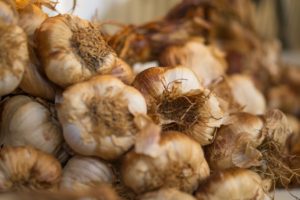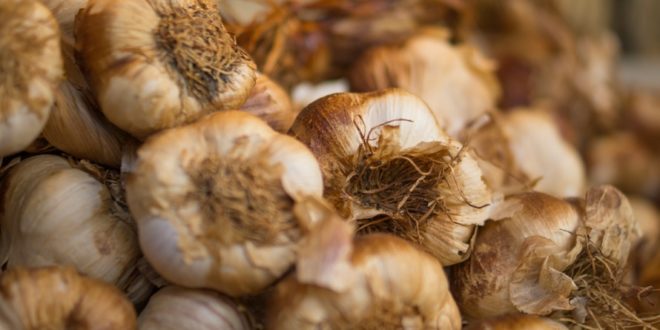Article by Julia Stewart
While we all know that garlic has many health benefits such as being a natural antibiotic, you may not know that they can also be healthy for your garden as well. As a companion plant, when they are planted near roses and raspberries, garlic will improve the growth and health of your plants. It has the added benefit of deterring Japanese beetles and aphids. Garlic is easy to grow and each planted clove will produce a full head of Garlic with between 8 to 20 cloves per head. To get started in with planting your garlic, first purchase your garlic of choice. Since the garlic from grocery stores has anti-sprouting chemicals added to it, be sure and buy your garlic from a reputable source rather than a grocery store. One variety that you may enjoy that is popular in the Mid-South US is the mild flavoured ‘Elephant’ garlic which has large clusters.
Planting Garlic
One half pound of garlic seed is a good start and will produce about 15 plants. Garlic is divided into hardnecks (Allium sativum var. ohioscorodon) and softnecks (Allium sativum var. sativum). First, check online catalogues or your local co-op for the variety that will suit your needs best.
Next, decide where you will plant your garlic. A raised bed is suggested if you do not have good soil or if you live in a wet climate. Good soil means loamy soil with a pH of 6.5 to 7.0. Composted manure for essential nutrients incorporated into soil a few weeks before planting is helpful. If you are planting your garlic directly into your soil, plant in wide-rows 10 to 12 inches wide. Timing is important when planting garlic. Bigger bulbs will be produced if you plant in the fall and let it grow and mature until the following summer. If you find that it’s springtime already and you haven’t planted yours yet, go ahead and plant if you like, just realize you will get smaller bulbs. Since garlic bulbs like cool weather, the earlier you can plant it the better it will grow and the bigger the bulbs will be.
Garlic is not susceptible to disease, but as with any plant, having good air circulation is the key to a healthy plant. If your garlic develops thrips, apply insecticidal soap. In cold climates, add more mulch a month after planting to prevent extreme temperature fluctuations. When growth appears in late winter, pull back the mulch and begin monthly applications of an organic fertilizer such as blood meal or fish emulsion. Stop fertilizing in mid to late spring (depending on what type of garlic you have). Mulch again as summer approaches.
 Harvesting Garlic
Harvesting Garlic
It takes about 100 days for bulbs planted in the spring to mature. Harvest between late may in warm climates and mid-August in cooler areas. Stop watering two weeks before harvest. One tip that garlic is ready to harvest is when the leaves on the lower half of the plant turn brown. To harvest, dig the bulbs up rather than pulling them up, being careful not to damage the outer skins.
Let them cure in a dry, shady, well ventilated location for three days. Don’t wash them yet. If you want to braid your garlic for a decorative touch, now is the time to braid the foliage of softnecks. Cure bulbs for 2 to 3 more weeks until foliage is completely dry. Once foliage is dry, clean the bulbs by wiping or peeling away the outer husk. Trim tops to 1 inch and roots to 1/2 inch.
Storing Garlic Bulbs
To store your garlic bulbs, place them in mesh bags or braided strings in a dark, cool place. Garlic will keep up to three months if stored at between zero degrees Celsius and room temperature. Humidity level of 65 to 70 percent is best.
Do not refrigerate.
Troubleshooting
Common causes of small or no bulbing include high temperatures, excessive watering, wrong cultivar for your climate, and weed competition. Your local extension service can advise you as to what varieties grow well in your area.
Both you and your garden can benefit from growing garlic. Checking online catalogue sources, your local extension service, or with your local garden centre will give you many varieties that are fun to try and that will grow well in your area.









Join the Discussion
Type out your comment here:
You must be logged in to post a comment.